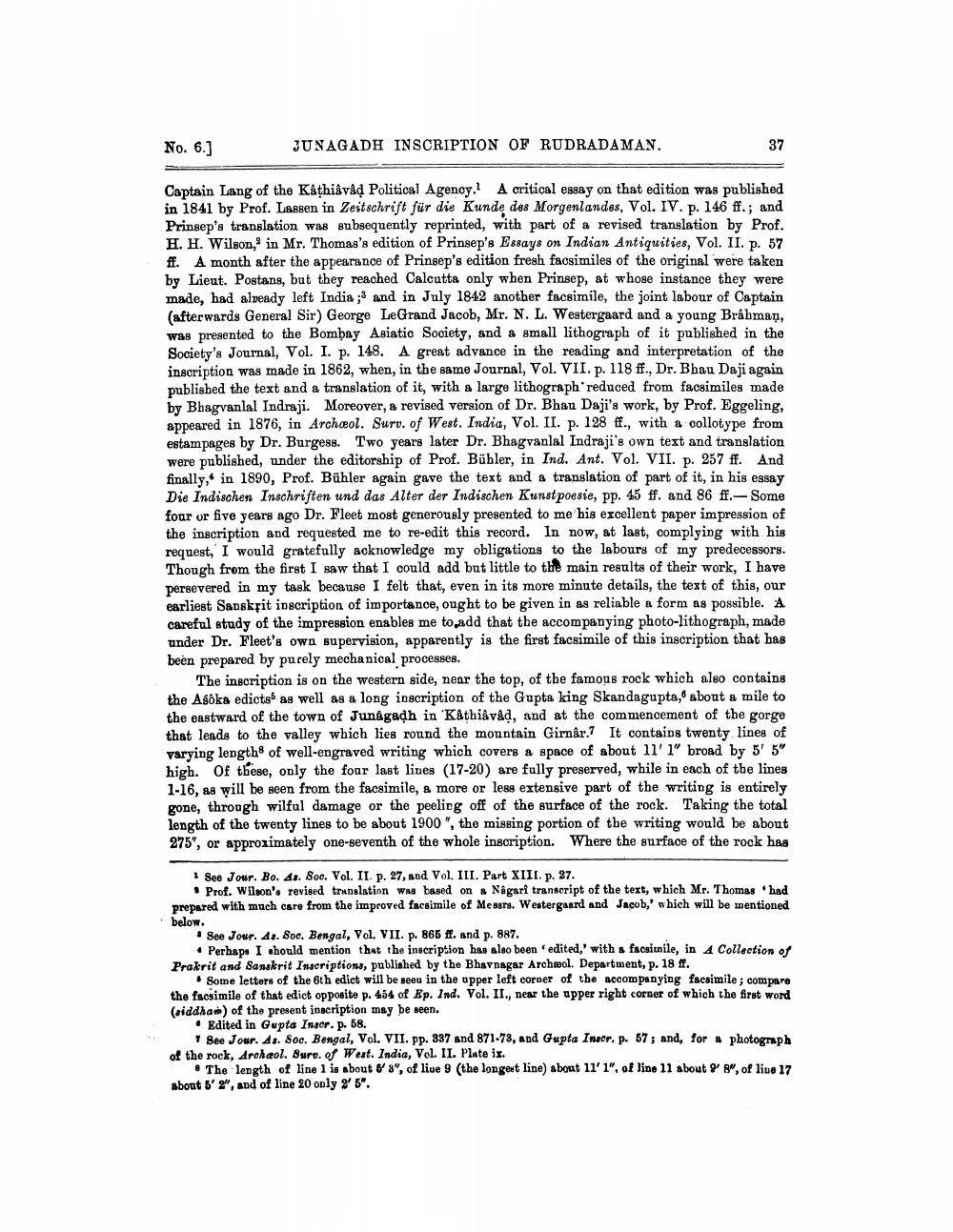________________
No. 6.]
JUNAGADH INSCRIPTION OF RUDRADAMAN.
Captain Lang of the Kathiâvad Political Agency? A critical essay on that edition was published in 1841 by Prof. Lassen in Zeitschrift für die Kunde des Morgenlandes, Vol. IV. p. 146 ff.; and Prinsep's translation was subsequently reprinted, with part of a revised translation by Prof. H. H. Wilson, in Mr. Thomas's edition of Prinsep's Essays on Indian Antiquities, Vol. II. p. 57 ff. A month after the appearance of Prinsep's edition fresh facsimiles of the original were taken by Lieut. Postans, but they reached Calcutta only when Prinsep, at whose instance they were made, had already left India ;) and in July 1842 another facsimile, the joint labour of Captain (afterwards General Sir George LeGrand Jacob, Mr. N. L. Westergaard and a young Brahman, was presented to the Bombay Asiatic Society, and a small lithograph of it published in the Society's Journal, Vol. I. p. 148. A great advance in the reading and interpretation of the inscription was made in 1862, when, in the same Journal, Vol. VII. p. 118 ff., Dr. Bhau Daji again published the text and a translation of it, with a large lithograph' reduced from facsimiles made by Bhagvanlal Indraji. Moreover, a revised version of Dr. Bhau Daji's work, by Prof. Eggeling, appeared in 1876, in Archæol. Surv. of West. India, Vol. II. p. 128 ff., with a collotype from estampages by Dr. Burgess. Two years later Dr. Bhagvanlal Indraji's own text and translation were published, under the editorship of Prof. Bübler, in Ind. Ant. Vol. VII. p. 257 ff. And finally, in 1890, Prof. Bühler again gave the text and a translation of part of it, in his essay Die Indischen Inschriften und das Alter der Indischen Kunstpoesie, pp. 45 ff. and 86 ff.- Some four or five years ago Dr. Fleet most generously presented to me bis excellent paper impression of the inscription and requested me to re-edit this record. In now, at last, complying with his request, I would gratefully acknowledge my obligations to the labours of my predecessors. Though from the first I saw that I could add but little to the main results of their work, I have persevered in my task because I felt that, even in its more minute details, the text of this, our earliest Sanskrit inscription of importance, ought to be given in as reliable a form as possible. A careful study of the impression enables me to add that the accompanying photo-lithograph, made under Dr. Fleet's own supervision, apparently is the first facsimile of this inscription that has been prepared by purely mechanical processes.
The inscription is on the western side, near the top, of the famous rock which also contains the Asöka edicts as well as a long inscription of the Gupta king Skandagupta, about a mile to the eastward of the town of Junagadh in Kathiâvâd, and at the commencement of the gorge that leads to the valley which lies round the mountain Girnar.7 It contains twenty lines of varying length of well-engraved writing which covers a space of about 11' 1' broad by 5' 5" high. Of these, only the four last lines (17-20) are fully preserved, while in each of the lines 1-16, as will be seen from the facsimile, & more or less extensive part of the writing is entirely gone, through wilful damage or the peeling off of the surface of the rock. Taking the total length of the twenty lines to be about 1900", the missing portion of the writing would be about 275", or approximately one-seventh of the whole inscription. Where the surface of the rock has
1 See Jour. Bo. 41. Soc. Vol. II. p. 27, and Vol. III. Part XIII. p. 27.
Prof. Wilson's revised translation was based on Nagari transcript of the text, which Mr. Thomas had prepared with much care from the improved facsimile of Messrs. Westergaard and Jacob,' which will be mentioned
below.
. See Jour. 43. Soc. Bengal, Vol. VII. p. 865 ff. and p. 887.
• Perhaps I should mention that the inscription has also been edited, with a facsiunile, in A Collection of Prakrit and Sanskrit Inscriptions, published by the Bhavnagar Archæol. Department, p. 18 ff.
. Some letters of the 6th edict will be seeu in the upper left corner of the accompanying facsimile; compare the facsimile of that ediet opposite p. 454 of Ep. Ind. Vol. II., near the upper right corner of which the first word (siddhan) of the present inscription may be seen.
• Edited in Gupta Inscr. p. 58.
* See Jour. As. 800. Bengal, Vol. VII. pp. 337 and 871-73, and Gupta Inor. p. 57; and, for photograph of the rock, Archæol. Sure of West. India, Vol. II. Plate is.
The length of line 1 is about 6'8", of live 9 (the longest line) about 11' 1", of line 11 about 8", of live 17 about B'?, and of line 20 only 2' 5'.




